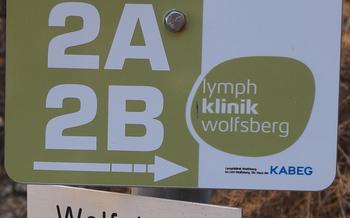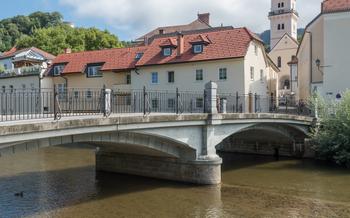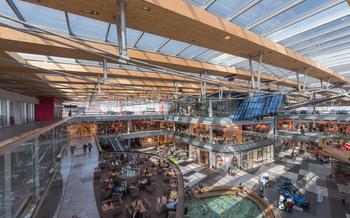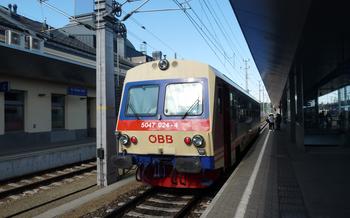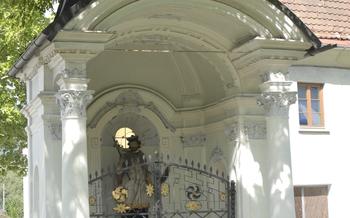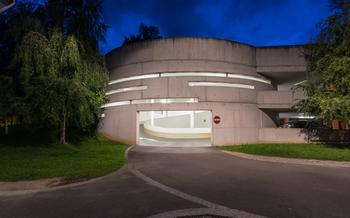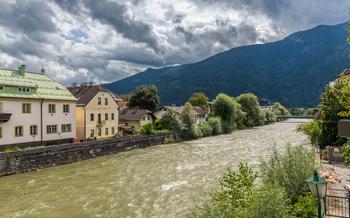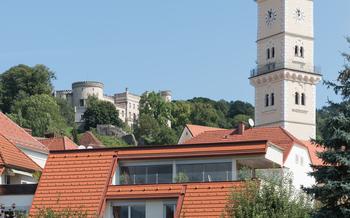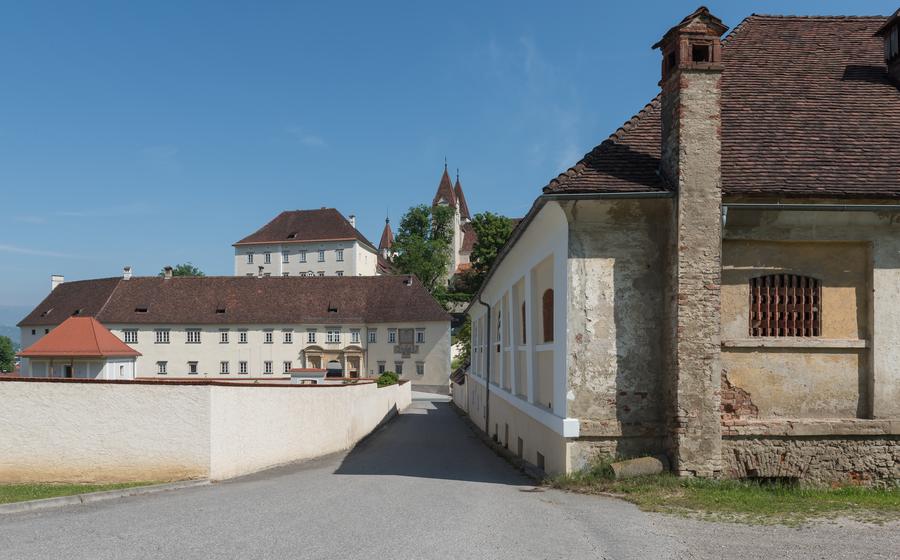
Benediktinerstift St. Paul
- A Millennial History
- A Spiritual Haven
- A Treasure Trove of Art
- Pilgrimage Destination
- Community Involvement
- Events and Festivals
- Guided Tours
- Self-Guided Exploration
- Practical Information
- Accommodation Options
- Dining Options
- Getting There
A Millennial History
The Benediktinerstift St. Paul, nestled in the heart of Wolfsberg, Austria, is a testament to a rich and storied past that spans over a millennium. Founded in 1091 by Count Ulrich von Heunburg, the abbey has stood as a beacon of spirituality, culture, and architectural ingenuity throughout the ages. Its history is intertwined with key events and milestones that have shaped its identity and significance.
Over the centuries, the abbey underwent several architectural transformations, reflecting the evolving tastes and techniques of different eras. In the 12th century, the Romanesque style dominated, characterized by its rounded arches and thick walls. The 13th century ushered in the Gothic period, with its soaring spires and intricate stained-glass windows. The Baroque era, in the 17th and 18th centuries, left its mark with opulent decorations and elaborate ornamentation.
Throughout its history, the Benedictine monks residing in the abbey played a pivotal role in the cultural and religious landscape of the region. They were not only devoted to prayer and contemplation but also engaged in various intellectual pursuits, including education, scholarship, and the arts. Their contributions to the community and the wider world earned them a reputation for excellence and profound spirituality.
A Spiritual Haven
Benediktinerstift St. Paul radiates with spirituality, serving as a beacon of faith and contemplation within the Catholic Church. The Benedictine monks, who have called this abbey home for centuries, adhere to the Rule of Saint Benedict, a set of principles that guide their daily lives and spiritual practices. They rise before dawn for prayers, dedicate themselves to work, study, and prayer throughout the day, and retire to their cells for reflection and rest.
Visitors to the abbey can immerse themselves in this sacred atmosphere and experience moments of tranquility and inner peace. The abbey's serene setting, surrounded by lush gardens and tranquil courtyards, invites contemplation and reflection. The harmonious blend of architecture, art, and nature creates a conducive environment for spiritual growth and renewal.
Pilgrims from around the world are drawn to the abbey, seeking solace, guidance, and a deeper connection with their faith. The abbey's rich history, coupled with its spiritual energy, provides a profound and meaningful experience for those seeking a spiritual journey.
A Treasure Trove of Art
The Benediktinerstift St. Paul is home to a remarkable collection of religious art that spans centuries and styles. Paintings, sculptures, and tapestries adorn the abbey's walls and altars, adding to its spiritual and aesthetic allure.
Among the highlights of the abbey's art collection is the "Madonna of St. Paul", a 15th-century wooden sculpture that is considered one of the finest examples of Gothic art in Austria. The sculpture depicts the Virgin Mary holding the infant Jesus, with a serene expression and intricate details that capture the essence of the mother-child bond.
Another notable artwork is the "Martyrdom of Saint Sebastian", a 17th-century painting by the Austrian artist Johann Michael Rottmayr. The painting portrays the martyrdom of Saint Sebastian, who was tied to a tree and pierced with arrows. Rottmayr's dramatic use of light and shadow, combined with the expressive figures, conveys the intensity of the scene and the saint's suffering.
The abbey's collection also includes a series of Baroque tapestries that depict scenes from the life of Saint Benedict. These tapestries, woven with vibrant colors and intricate designs, add a touch of grandeur to the abbey's interior and provide a glimpse into the life and teachings of the Benedictine order.
Visitors to the Benediktinerstift St. Paul can admire these and many other artworks as they explore the abbey's various spaces. The abbey's art collection not only enhances the spiritual experience but also offers a fascinating journey through the history of art and the evolution of religious iconography.
Pilgrimage Destination
Benediktinerstift St. Paul holds a significant place on the Camino de Santiago, the ancient pilgrimage route that leads to the tomb of Saint James the Great in Santiago de Compostela, Spain. Pilgrims from all over Europe have traversed this path for centuries, seeking spiritual enlightenment and renewal. The abbey's association with Saint Paul the Apostle, a revered figure in Christianity, further enhances its allure as a pilgrimage site.
The abbey offers a welcoming haven for pilgrims, providing accommodation, spiritual guidance, and a sense of community. Pilgrims can participate in special services, attend Mass, and receive blessings from the Benedictine monks. The abbey's serene atmosphere and the opportunity for reflection and contemplation make it an ideal place for pilgrims to find inner peace and connect with their faith.
Undertaking a pilgrimage to Benediktinerstift St. Paul is not just a journey of physical endurance but a profound spiritual experience. Pilgrims embark on a transformative journey, shedding worldly concerns and embracing a deeper connection with themselves, their faith, and the divine. The abbey's centuries-old tradition of hospitality and its commitment to providing a welcoming environment for pilgrims make it a cherished destination for those seeking spiritual renewal and a meaningful pilgrimage experience.
Community Involvement
The Benediktinerstift St. Paul is deeply embedded in the local community, playing a pivotal role in its social, educational, and cultural fabric. The abbey's commitment to social welfare extends beyond its spiritual mission, as it actively engages in initiatives that address societal needs and promote community development.
One of the key areas of the abbey's community involvement is education. The abbey has a long tradition of supporting local schools and educational institutions, providing financial assistance to students from disadvantaged backgrounds and organizing educational programs for the youth. The abbey also runs its own kindergarten and primary school, offering a holistic education that integrates spiritual and academic development.
In the realm of healthcare, the abbey has been instrumental in establishing and supporting hospitals, nursing homes, and other healthcare facilities in the region. The abbey's commitment to providing quality healthcare to the community is evident in its partnerships with local healthcare organizations and its ongoing efforts to improve access to medical services for all.
Furthermore, the abbey actively collaborates with local organizations and institutions to address social issues and promote community empowerment. The abbey's initiatives range from providing counseling and support to families in need to organizing workshops and events that foster community engagement and social cohesion.
Through its deep-rooted ties with the local community, the Benediktinerstift St. Paul serves as a catalyst for positive change and community empowerment. The abbey's commitment to social welfare and its vielfältig range of initiatives contribute significantly to the wellbeing and prosperity of the surrounding region.
Events and Festivals
Benediktinerstift St. Paul comes alive with a vibrant calendar of events and festivals that showcase its rich cultural and spiritual heritage. Throughout the year, the abbey hosts a variety of celebrations, offering visitors an immersive experience of its traditions and community spirit.
One of the highlights is the annual St. Paul's Day Festival, held on June 29th. This grand celebration honors the patron saint of the abbey and features a colorful procession, festive music, and traditional Austrian cuisine. Visitors can join in the merriment, witness the parade of costumed participants, and enjoy the lively atmosphere that fills the abbey grounds.
For music enthusiasts, the abbey's International Music Festival is a must-attend event. Held during the summer months, this prestigious festival features performances by renowned musicians from around the world. The concerts take place in the abbey's stunning basilica, creating an unforgettable acoustic experience.
During the Christmas season, the abbey transforms into a winter wonderland, hosting a series of Advent concerts and festive events. Visitors can indulge in the enchanting atmosphere, listen to heartwarming music, and witness the abbey's beautiful Christmas decorations.
These are just a few examples of the many events and festivals that take place at Benediktinerstift St. Paul. By planning a visit to coincide with one of these special occasions, you can immerse yourself in the abbey's vibrant cultural traditions and create memories that will last a lifetime.
Guided Tours
Venturing through the hallowed halls of Benediktinerstift St. Paul is an experience best savored with the insights of a knowledgeable guide. Guided tours, available in multiple languages, bring the abbey's rich history, captivating architecture, and remarkable collections to life. These experienced guides, passionate about the abbey's legacy, share fascinating anecdotes and delve into the finer details of its evolution.
Through their storytelling, visitors are transported back in time, witnessing the trials and triumphs that shaped this sacred space. From the founding of the abbey in the 11th century to its architectural transformations over the centuries, the guides provide a vivid narrative that illuminates the abbey's enduring significance.
Guided tours offer an unparalleled opportunity to ask questions, delve deeper into specific aspects of the abbey, and gain a profound understanding of its spiritual, cultural, and historical significance. Whether seeking insights into the Benedictine way of life, admiring the intricate details of the abbey's architecture, or exploring the treasures of its library, visitors are sure to leave with a newfound appreciation for this extraordinary site.
Self-Guided Exploration
The Benediktinerstift St. Paul offers visitors the flexibility to explore its wonders at their own pace through self-guided tours. Embark on a journey of discovery, immersing yourself in the abbey's rich history, architecture, and collections.
The self-guided tour route is designed to highlight the abbey's key features and points of interest. Explore the magnificent basilica, adorned with intricate frescoes and stained glass windows. Wander through the serene cloister, where the Benedictine monks once walked in contemplation. Delve into the abbey's library, a treasure trove of knowledge housing ancient manuscripts and rare books.
With audio guides available in multiple languages, you can delve deeper into the abbey's stories and uncover its hidden secrets. Listen to captivating narratives that bring the abbey's history and legacy to life. Alternatively, opt for a self-guided tour booklet that provides detailed information and insights into each section of the abbey.
The beauty of self-guided exploration lies in the freedom to customize your visit according to your interests and time constraints. Spend as much time as you wish admiring the intricate details of the abbey's architecture, or linger in the library, immersing yourself in the world of books and manuscripts.
Plan your self-guided tour carefully to make the most of your experience. Allocate enough time to explore each section of the abbey, and don't forget to bring your camera to capture the stunning beauty of your surroundings. Embrace the opportunity to connect with the abbey's spiritual essence and create lasting memories of your visit.
Practical Information
Before embarking on your journey to Benediktinerstift St. Paul, it's essential to be well-informed about practical matters to ensure a smooth and enjoyable visit.
-
Opening Hours: The abbey is generally open to the public from 9 am to 6 pm daily, with variations depending on the season and special events. It's advisable to check the official website or contact the abbey directly for up-to-date information.
-
Admission Fees: A standard admission ticket grants access to the abbey's church, cloister, library, and museum. Fees vary for adults, students, and children, with discounts available for groups and families. Guided tours typically incur an additional charge.
-
Accessibility: The abbey is committed to providing an inclusive environment for all visitors. Wheelchair ramps, elevators, and accessible restrooms are available throughout the premises. Visitors with disabilities are encouraged to contact the abbey in advance to arrange any necessary assistance.
-
Facilities and Amenities: The abbey offers a range of facilities to enhance the visitor experience. Clean and well-maintained restrooms are located conveniently throughout the complex. Dining options include a cafeteria serving light refreshments and a restaurant offering a more substantial menu featuring regional cuisine. A gift shop provides a variety of souvenirs, books, and religious items.
Accommodation Options
When planning your visit to Benediktinerstift St. Paul, a range of accommodation options awaits you, catering to different budgets and preferences. Whether you seek a cozy hostel stay, a charming guesthouse experience, or the comforts of a hotel, you'll find suitable options in the vicinity of the abbey.
For budget-conscious travelers, several affordable hostels offer a comfortable and social environment. These hostels often provide shared dormitories, allowing you to meet fellow travelers and share stories of your journey.
If you prefer a more private and personalized experience, guesthouses offer a warm and welcoming atmosphere. Many guesthouses in the area are family-run, providing a glimpse into the local culture and hospitality.
For those seeking a luxurious stay, several hotels near the abbey offer upscale amenities and elegant accommodations. These hotels often feature spacious rooms, fine dining options, and spa facilities, ensuring a truly memorable stay.
To fully immerse yourself in the region's charm, consider combining your visit to the abbey with a longer stay in the surrounding area. Explore the picturesque villages, indulge in outdoor activities, and discover the region's rich history and culture.
When booking your accommodation, remember to consider factors such as location, budget, and amenities. Advance reservations are recommended, especially during peak tourist season, to secure your preferred choice.
Dining Options
A visit to the Benediktinerstift St. Paul is not complete without savoring the culinary delights of the region. In the vicinity of the abbey, visitors can find a range of dining options that cater to diverse tastes and preferences. From traditional Austrian cuisine to international fare, there's something for everyone to enjoy.
For those seeking an authentic Austrian experience, the Gasthof-Hotel Karnerhof is a must-visit. This traditional inn offers a cozy ambiance and a menu filled with regional specialties. Indulge in hearty schnitzel, flavorful käsespätzle, or the famous tafelspitz, a boiled beef dish served with horseradish sauce.
Another excellent option is the Restaurant Schloss Wolfsberg, located in the nearby Wolfsberg Castle. This elegant restaurant offers a more upscale dining experience with a focus on modern Austrian cuisine. The menu features dishes that highlight seasonal ingredients and showcase the region's culinary heritage with a contemporary twist.
For a quick and casual bite, visitors can head to the Café Konditorei Ertl, a local favorite known for its delicious pastries and cakes. Enjoy a cup of coffee and a slice of freshly baked apfelstrudel while taking in the charming atmosphere of this traditional Viennese coffeehouse.
No matter what your taste buds desire, you're sure to find a delightful dining experience near the Benediktinerstift St. Paul. Embrace the opportunity to sample regional specialties and immerse yourself in the local food culture.
Getting There
Benediktinerstift St. Paul is conveniently accessible by various means of transportation, allowing visitors to choose the option that best suits their preferences and travel plans.
For those arriving by car, the abbey is easily reachable via the A2 motorway. Simply take exit 136 (St. Paul im Lavanttal) and follow the signs to the abbey. Ample parking is available on-site, ensuring a hassle-free visit.
Public transportation is also a viable option for reaching the abbey. The closest train station is St. Paul im Lavanttal, which is served by regional trains from several major cities in Austria. From the train station, visitors can take a short bus ride or taxi to the abbey.
Guided tours are an excellent way to combine transportation with a comprehensive introduction to the abbey's history and significance. Many tour operators offer day trips or multi-day itineraries that include a visit to the abbey, often paired with other attractions in the region.
To make the journey even more scenic, consider flying into Klagenfurt Airport (KLU), which is approximately an hour's drive from the abbey. The drive offers stunning views of the Carinthian countryside, making the journey a memorable experience in itself.
No matter your chosen mode of transport, getting to Benediktinerstift St. Paul is a breeze. Embrace the journey and enjoy the anticipation as you approach this architectural and spiritual masterpiece.
